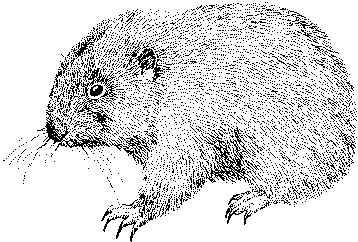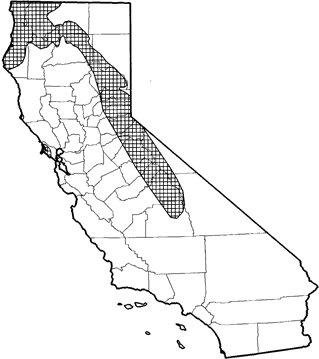
Mountain Beaver
Distribution, Abundance, and Seasonality
Found throughout the Cascade, Klamath, and Sierra Nevada Ranges. Distribution often is scattered; populations local and uncommon in the Sierra Nevada and other interior areas. Mountain beavers occur in dense riparian-deciduous and open, brushy stages of most forest types. Typical habitat in the Sierra Nevada is montane riparian; in the Coast Ranges, most populations occur below 900 m (2700 ft) (Borrecco and Anderson 1980). Frequent open and intermediate-canopy coverage with a dense understory near water. Deep, friable soils are required for burrowing, along with a cool, moist microclimate.

Range Map
Specific Habitat Requirements
Feeding: Feed on vegetative parts of plants, mostly thimbleberry, salmonberry, blackberry, dogwood, salal, ferns, lupines, willows, and grasses. Voth (1968) found, in western Oregon, males and nonpregnant females fed on ferns (85%), deciduous trees (5%), and conifers (3%); lactating females (April through June) fed on ferns (45%), conifers (34%). grasses (18%), and forbs (3%). Coprophagous. Voth (1968) found changes in diet related to protein content of available vegetation. Forage underground, on ground, under snow, on surface of snow, and up to 4.5 m (15 ft) in trees and bushes. Vegetation is stored near a burrow entrance or in underground chambers (Maser et al. 1981).
Cover: Burrows and dense understory vegetation provide cover.
Reproduction: Burrows are located in deep soils in dense thickets, preferably near a stream or spring. Line nest with dry vegetation. Nest chambers situated 0.3 to 1.5 m (1 to 4.5 ft) below the ground surface.
Water: Mountain beavers do not concentrate urine and require a large daily intake of water (Nungesser and Pfeiffer 1965, Schmidt-Nielsen and Pfeiffer 1970). Most burrows contain water. In captivity, require 22% of body weight, or about 8 oz (218 g), of drinking water per day. In captivity, an individual lived 2? mo on lush vegetation with no drinking water (Nungesser and Pfeiffer 1965, Schmidt-Nielsen and Pfeiffer 1970).
Pattern: Frequent dense riparian-deciduous vegetation .
Species Life History
Activity Patterns: Active yearlong. Mostly nocturnal occasionally diurnal (Maser et al. 1981).
Seasonal Movements / Migration: Sedentary and non-migratory.
Home Range: Home range small; varied from 400-2000 m2 (4400-21,800 ft?), with a mean of 1000 m? (10,900 ft?) near Montesano, Washington (Martin 1971). Goslow (1964) estimated home ranges in Humboldt Co. varied from 5.6-279 m? (60-3,000 ft?). Home ranges often overlap. Most activity occurs within 24 m (80 ft) of nest (Martin 1971, Lovejoy 1972, Neal and Borrecco 1981). In forest stands, densities seldom exceed 4/ha (1.5/ac); in logged or disturbed areas, densities may rise to an average of 6-7/ha (3/ac) and a high of 15-20/ha (8/ac) (Hooven 1977, Neal and Borrecco 1981).
Territory: Defend burrow systems and nest sites(Goslow 1964, Borrecco and Anderson 1980).
Reproduction: Mountain beavers breed fron December through March (peak in February). Young born February to June (peak March through May). One litter per yr; gestation 28-30 days; lactation lasts up to 60 days. Litter size averages 2-3 (range 1-5). Females usually do not bear young until their second yr. Longevity is unknown, but individuals have lived 3 yr in captivity (Martin 1971, Hooven 1977, Lovejoy and Black 1979b). Maximum life expectancy estimated to be 6 yr.
Niche: Occasionally damage coniferous tree plantations with burrowing and gnawing. Shrews, moles. snowshoe hares, brush rabbits, deer mice, voles, minks long-tailed weasels, and spotted skunks use mountain beaver burrows (Maser et al. 1981). Predators include bobcats, long-tailed weasels, minks, coyotes, and owls.
Sources & References
California Department of Fish and Game, 1999.
California's Wildlife, Sacramento, CA.
Written by: C. Polite, reviewed by: M. White, edited by: M. White
Allen, L. O. 1969. Preferential food habits of Aplodontia rufa. M.S. Thesis. Central Washington Coll., Ellensburg. 55pp.
Borrecco, J. E., and R. J. Anderson, 1980. Mountain beaver problems in the forests of California, Oregon, and Washington. 9th Vertebr. Pest Conf. Procs:135-142 Borrecco, J. E., H. W. Anderson, H. C. Black, J. Evans, K. S. Guenther, G. D. Lindsey, R. P. Mathews, and T. K. Moore. 1979. Survey of mountain beaver damage to forests in the Pacific Northwest, 1977. Wash. Dep. Nat. Resours., Olympia. DNR Note No. 26. 16pp. Godin, A. J. 1964. A review of the literature of the mountain beaver. USDI, Fish and Wildl. Serv. Spec. Sci. Rep., Wildl. No. 78. 52pp. Goslow, G. E. 1964. The mountain beaver, Aplodontia rufa. M.S. Thesis, Humboldt State Univ., Arcata. 74pp.
Hooven, E. F. 1977. The mountain beaver in Oregon: its life history and control. Oregon State Univ., For. Res. Lab., Res. Pap. No. 30. Corvallis. 20pp. Ingles, L. G. 1959. A quantitative study of mountain beaver activity. Amer. Midl. Nat. 61:419- 423. Johnson, S. R. 1971. The thermal regulation, micro-climate, and distribution of the mountain beaver, Aplodontia rufa pacifica Merriam. Ph.D. Thesis, Oregon State Univ., Corvallis. 164pp. Kinney, J. L. 1971. Environmental physiology of a primitive rodent. Ph.D. Thesis, Univ. Oregon, Eugene. 181pp. Lovejoy, B. P. 1972. A capture-recapture analysis of a mountain beaver population in western Oregon. Ph.D. Diss., Oregon State Univ., Corvallis. 105pp.
Lovejoy, B. P., and H. C. Black. 1979a. Movements and home range of the Pacific mountain beaver, Aplodontia rufa pacifica. Amer. Midl. Nat. 101:393-402. Lovejoy, B. P., and H. C. Black. 1979b. Population analysis of the mountain beaver, Aplodontia rufa pacifica, in western Oregon. Northwest Sci. 53:82-89. Lovejoy, B. P., H. C. Black, and E. F. Hooven. 1978. Reproduction, growth and development of the mountain beaver (Aplodontia rufa pacifica). Northwest Sci. 52:323-328. Martin, P. 1971. Movements and activities of the mountain beaver (Aplodontia rufa). J. Mammal. 52:717-723. Maser, C., B. R. Mate, J. F. Franklin, and C. T. Dyrness. 1981. Natural history of Oregon coast mammals. Pac. Northwest For. And Range Exp. Sta., USDA, For. Serv., Gen. Tech. Rep., PNW-133. 496pp. Neal, F. D., and J. E. Borrecco. 1981. Distribution and relationship of mountain beaver to openings in sapling stands. Northwest Sci. 55:79-86. Nungesser, W. C., and E. F. Pfeiffer. 1965. Water balance and maximum concentration capacity in the primitive rodent, Aplodontia rufa. Biochem. Physiol. 14:289-297. Orr, R. T. 1971. Mammals of North America. Doubleday, New York. 250pp. Pfeiffer, E. W. 1958. The reproductive cycle of the female mountain beaver. J. Mammal. 39:223-235. Scheffer, T. H. 1929. Mountain beaver in the Pacific Northwest: their habits, economic status and control. USDA, Farmers Bull, No. 1958. 18pp. Schmidt-Nielsen, K., and E. W. Pfeiffer. 1970. Urea and urinary concentrating ability in the mountain beaver Aplodontia rufa. Amer. J. Physiol. 218:1370-1375. Voth, E. H. 1968. Food habits of the Pacific mountain beaver, Aplodontia rufa pacifica Merriam. Ph.D. Diss. Oregon State Univ., Corvallis. 263pp. Williams, D. F. 1986. Mammalian species of special concern in California. Calif. Dept. Fish and Game, Sacramento. Admin. Rep. 86-1. 112pp.
California Animal Facts | California's Wildlife